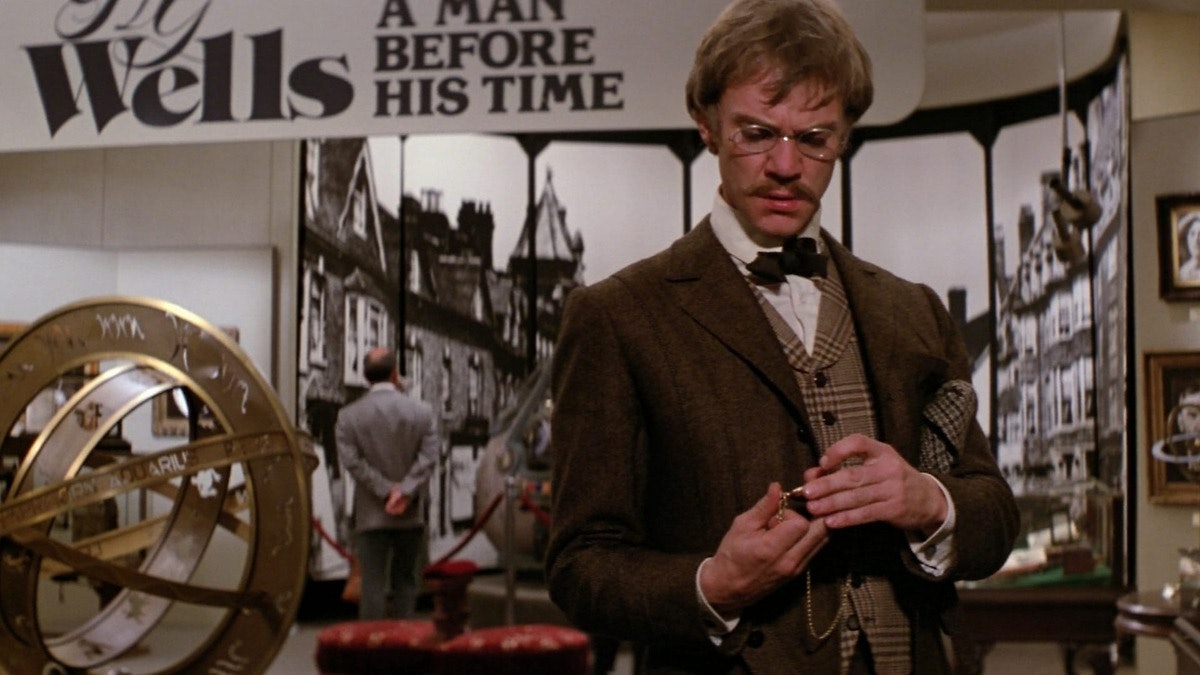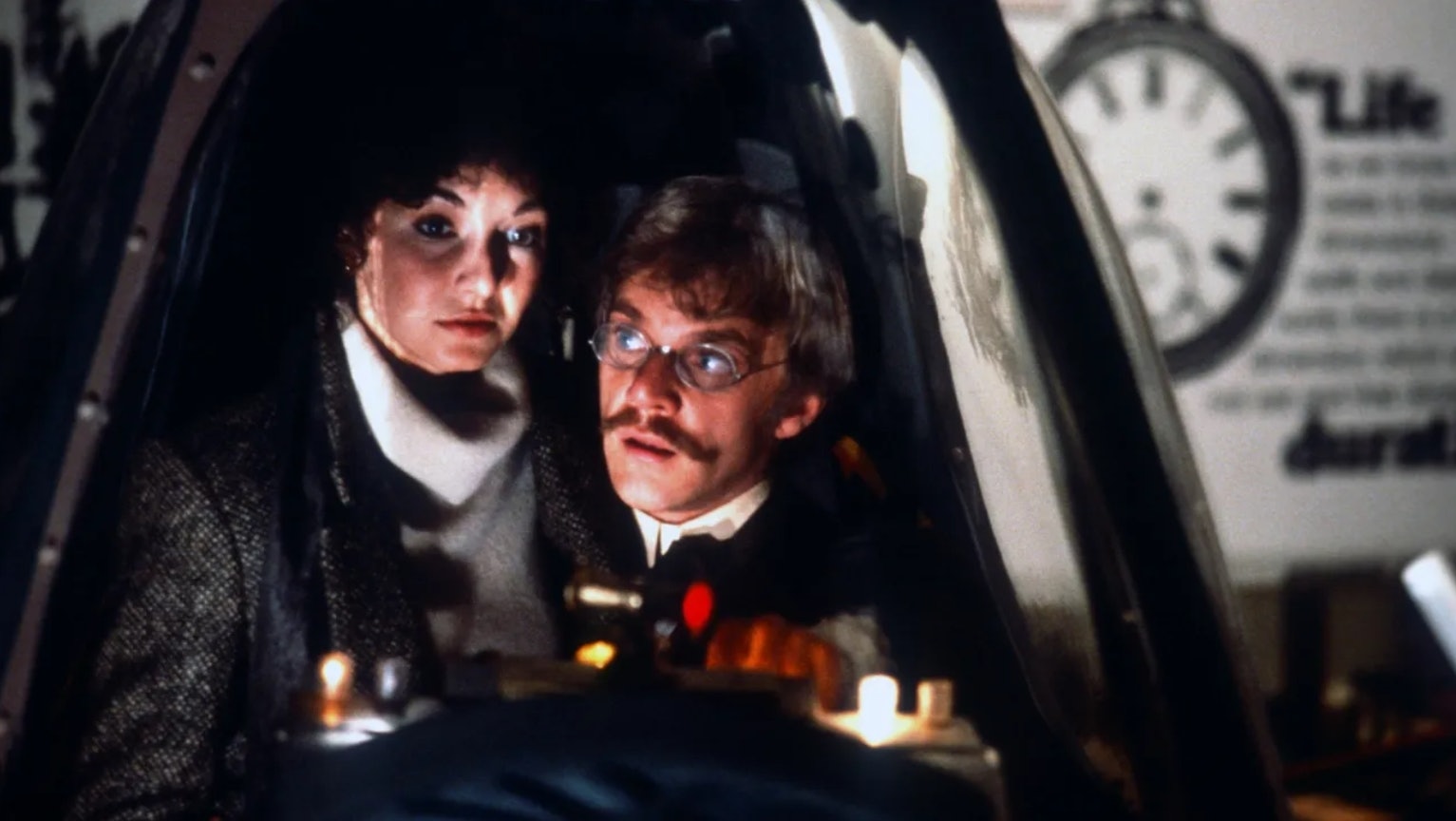
When Time After Time was released 45 years ago this day, it brought the concept of time travel back to its Victorian-era roots by channeling the work of H.G. Wells, whose 1895 novel The Time Machine had introduced the idea to a broad audience. The 1979 movie, however, made Wells himself the story's protagonist. In the film, written and directed by Nicholas Meyer based on a then-unfinished Kent Alexander novel, Wells (Malcolm McDowell) constructs a time-travel device that’s hijacked by a colleague, Dr. John Leslie Stevenson (David Warner), who turns out to be Jack the Ripper. Don’t you hate it when that happens?
Stevenson travels forward more than 85 years to modern-day San Francisco. Wells is right behind him, thanks to a fail-safe that automatically sends the machine back to its own time. As both react to life in 1979 — Stevenson inspired by the pervasive bloodshed, Wells horrified that his dream of a future utopia didn’t come to pass — Stevenson restarts his murderous ways while Wells falls in love with Amy Robbins (Mary Steenburgen), a free-spirited woman who eventually becomes the Ripper’s next target.
Time After Time was arguably the first major Hollywood film to use what we would now call a steampunk aesthetic since the early 1960s, when films like Master of the World (1961) and First Men in the Moon (1964) were released. But while those were set in a single time period, Time After Time dropped late 19th-century figures into the modern world. Using people out of history was fairly common in sci-fi and fantasy literature, but hadn’t been visualized onscreen quite like this before.
The film was Meyer’s directorial debut, although as a writer, he’d earned acclaim for his revisionist Sherlock Holmes novel The Seven-Per-Cent Solution and its 1976 film adaptation. Fittingly, the story featured Holmes interacting with real-life psychoanalyst Sigmund Freud, foreshadowing Meyer’s use of H.G. Wells as a character. But more importantly, the DNA of Time After Time can be seen in Meyer’s later work as a writer and director of Star Trek films.
Meyer directed and co-wrote 1982’s Star Trek II: The Wrath of Khan, in which a figure out of the past – the genetic superman Khan (Ricardo Montalban) – quickly adjusts to life in the present and wreaks havoc, much like Jack the Ripper. Meyer’s screenplay for Star Trek IV: The Voyage Home (1986) used even more specific plot points that he’d tried out in Time After Time.
In both films, the main characters time travel to 20th-century San Francisco, where they must puzzle out concepts like currency and transportation. In Time After Time, Wells and Stevenson exchange old (but still valid) British currency for American dollars, while Captain Kirk (William Shatner) sells his antique glasses for cash in Star Trek IV. In an interview with IGN, Meyer mentioned repurposing a deleted Time After Time scene in which Wells is stuck at a “Don’t Walk” sign next to a punk rocker blasting loud music. In Star Trek IV, Kirk and Spock (Leonard Nimoy) are seated on a bus opposite a mohawked dude doing just that, at least until Spock uses the Vulcan neck pinch to shut him down.

Perhaps the biggest similarity between the two films, however, involves their female protagonists. At the end of Time After Time, Amy Robbins decides she wants to spend her life with Wells and travels back with him to his own time, the late 1800s. At the climax of Star Trek IV, marine biologist Gillian Taylor (Catherine Hicks), who’s developed a mutual attraction with Kirk, hitches a ride with the Enterprise crew to the future, where she’ll presumably look after the whales she helped save and grab dinner again with the captain.
Funnily enough, this idea later appeared in another sci-fi franchise featuring Time After Time’s Mary Steenburgen. In Back to the Future Part III (1990), Steenburgen plays Clara Clayton, a schoolteacher Doc Brown (Christopher Lloyd) falls in love with when he travels back to the Old West circa 1885. Just as Wells tells Amy he has to return to his own era, Doc tells Clara the same thing, and she responds the same way, expressing shock before ultimately deciding she wants to be with Doc as he voyages through time.
As Steenburgen recalled in a 1990 interview, “Actually, I've played the same scene in [Time After Time] and in [Back to the Future] Part III. I've had a man from a different time period tell me that he's in love with me, but he has to go back to his own time…It's a pretty strange feeling to find yourself doing the same scene, so many years apart, for the second time in your career."
But maybe it’s not really so strange when you’re dealing with movies about time travel. And in the case of Time After Time, Nicholas Meyer’s charming little sci-fi adventure impacted future films in ways that not even H.G Wells himself might have predicted.







